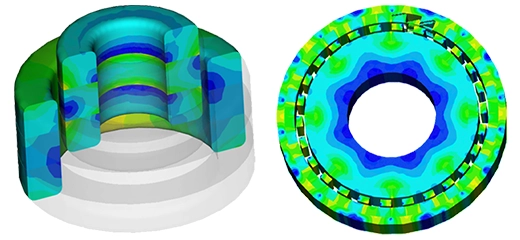MIMO Antenna Systems
MIMO (Multiple Input Multiple Output) antenna systems enhance wireless communication by increasing data rates, reliability, and reducing interference across various applications like smartphones, IoT devices, and military platforms. However, they require high-cost RF modules, more complex hardware, and can drain battery life faster. Simulation and virtual prototyping are essential for precise engineering and optimal performance of these complex systems.
A typical MIMO system
MIMO Design Challenges
Designing MIMO antenna systems presents challenges such as managing high-cost RF modules, increased hardware complexity, and faster battery drain due to intensive signal processing. Key factors include the number and position of antenna elements, signal bandwidth, achieved antenna gain, mutual coupling between elements, signal interference, and electromagnetic compatibility (EMC) and safety. Extensive simulation and virtual prototyping are essential for precise engineering and optimal performance.
Example of a MIMO system
EMWORKS Platform
EMWORKS overcomes MIMO antenna design challenges with advanced simulation and virtual prototyping tools. It optimizes antenna element positioning, signal bandwidth, and gain, while managing interference and mutual coupling. EMWORKS ensures EMC and safety through detailed field analysis. Its iterative optimization process allows for continual refinement, resulting in high-performance, cost-effective, and reliable MIMO antennas for diverse applications, including smartphones, IoT devices, and military platforms.
Design Details
The 3.6 GHz MIMO antenna system for smartphones features dual-polarized eight-antenna elements utilizing square-ring slot antenna types. It operates within a 2.7 GHz to 4.5 GHz frequency range and measures 150mm x 75mm x 1.6mm. Equipped with 50 Ohm coaxial feeding connectors, this design ensures optimal performance and connectivity for modern smartphone applications.
CAD model of the MIMO antenna
Performance in free space
The 3.6 GHz MIMO antenna system, designed for smartphones and operating in free space, demonstrates excellent return loss characteristics, with a resonance around -30 dB observed at 3.6 GHz. This low return loss indicates efficient impedance matching and minimal signal reflection, ensuring enhanced signal integrity and optimal performance across the operating frequency range of 2.7 GHz to 4.5 GHz for high-speed wireless communication.
Return loss for all ports in free space
The 3D polar plot gain pattern at 3.6 GHz for the MIMO antenna system reveals the directional characteristics and performance efficiency of the antenna elements. This plot demonstrates how the antenna radiates energy in three-dimensional space, providing insights into the gain distribution. At 3.6 GHz, the gain pattern indicates strong, focused radiation, essential for reliable high-speed wireless communication, minimizing signal loss and interference while maximizing coverage and performance.
3D Polar plot Gain pattern at 3.6GHz in free space
The electric field distribution at 3.6 GHz for the MIMO antenna system offers crucial insights into the electromagnetic behavior of the antenna elements. This distribution highlights areas of strong and weak electric fields, indicating how effectively the antenna radiates and receives signals. At 3.6 GHz, the electric field distribution ensures optimal signal propagation and reception, enhancing the antenna's performance in terms of gain, efficiency, and overall communication reliability in wireless applications.
E-Field distribution at 3.6 GHz
Performance near human head
The return loss of the 3.6 GHz MIMO antenna system changes when operating near a human head compared to free space. In free space, the antenna shows excellent return loss characteristics, with a resonance around -30 dB at 3.6 GHz, indicating efficient impedance matching and minimal signal reflection. However, near a human head, the return loss increases with a shift in the resonance signalling a decrease in the efficiency. This is due to the human body's dielectric properties affecting the electromagnetic field, causing greater signal absorption and reflection. As a result, the antenna's performance degrades in terms of return loss, necessitating design adjustments or compensation techniques to maintain optimal functionality in real-world scenarios where proximity to the human body is common.
Mesh of the MIMO next to a human head.
Return loss for all ports near human head.
The 3D polar plot gain pattern of the 3.6 GHz MIMO antenna system changes when operating near a human head compared to free space. In free space, the gain pattern is strong and focused. Near a human head, the pattern becomes distorted, with reduced gain and increased sidelobes due to signal absorption and scattering. This distortion necessitates design adjustments to maintain reliable performance in practical applications involving human proximity.
3D Polar plot Gain pattern at 3.6GHz near human head.
Design Scenarios
We placed the antenna at several positions relative to the human head, as outlined in the table below:
We then computed the S11 parameter for all five scenarios. The results show that as the antenna gets closer to the head, the return loss increases, and the resonance shifts more significantly. This indicates a degradation in antenna performance due to the proximity of the human head, requiring careful design considerations to mitigate these effects.
S11 for all five scenarios.
The Specific Absorption Rate
The Specific Absorption Rate (SAR) distribution on the human head was analyzed to assess the electromagnetic exposure levels from the 3.6 GHz MIMO antenna system. The SAR distribution indicates how much radio frequency energy is absorbed by the head tissues. Higher SAR values were observed near the antenna's proximity, highlighting regions with greater energy absorption. Ensuring that SAR levels remain within safety limits is crucial to protect users from potential health risks associated with prolonged exposure to electromagnetic fields.
SAR distribution on the human head
The temperature distribution
The temperature distribution on the human head was analyzed for a 3-minute exposure to the 3.6 GHz MIMO antenna system. The analysis revealed localized temperature increases in areas closest to the antenna, correlating with regions of higher energy absorption. While the overall temperature rise was within safe limits, monitoring and managing these hot spots is essential to ensure user comfort and prevent any potential thermal effects during prolonged use.
Temperature distribution after 3 minutes exposure.
We also examined the maximum temperature on the head for all five scenarios at various distances from the head. The analysis showed that the closer the antenna is to the head, the higher the maximum temperature observed. This correlation highlights the importance of considering distance to minimize thermal effects and ensure user safety during prolonged exposure to the 3.6 GHz MIMO antenna system.
Maximum temperature vs distance for a 3-minute exposure.
In conclusion, the virtual prototyping and detailed analysis of the 3.6 GHz MIMO antenna system for smartphones highlight the importance of simulation tools like EMWORKS in overcoming design challenges. By addressing issues related to return loss, gain patterns, and SAR, and temperature distributions, EMWORKS ensures that MIMO antenna systems meet performance, safety, and reliability standards for modern wireless communication applications.



